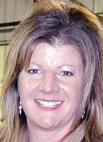
Ian and Kassi Glassman change breeds and locations, but continue to breed for the best cattle possible
Pastures dotted with large, muscled, white cattle defined the childhoods of Ian and Kassi Glassman. The Glassmans hold dear their upbringings raising Charolais cattle.
Kassi grew-up as a sixth-generation farmer on a 21,000-acre ranch on the Wyoming/Colorado border, and Ian, was the son of first-time hobby farmers in Carthage, Mo.
The couple first met as teenagers at a Charolais Junior Nationals in Mississippi. Though mere acquaintances then, their involvement in the Charolais show circuit caused their lives to cross once more in 2012.
After getting married, the Glassmans operated a large ranch, Utopia Genetics, in Grovespring, Mo. But soon they found their 3,400-acre farm, spread out over three locations in two counties, was too much for the two of them to handle alone.
In 2015, the Glassmans chose to make a dramatic change.
Utopia Genetics sold its farm and dispersed its Charolais herd. Instead of holding on the to the familiar white cattle; they opted to keep a handful of Simmental percentage and purebred cows.
“Basically at that time it was because of the numbers,” Ian explained. “We had way too many whites and we had a handful of Simmentals. We always liked the Simmental breed and it was interesting and new.”
The Glassmans moved Utopia Genetics to a 356-acre farm near Ash Grove, Mo. On their new property they pour their expertise into producing show-stopping Simmental females. “I am still a Charolais fan, but the Simmentals combine good maternal aspects and carcass value. We have enjoyed them for sure,” Kassi said.
Utopia Genetics owns a handful of percentage and purebred Simmental donor cows; the rest of the herd consists of recips. Utopia Genetics specializes in embryo-transfer calves, raising close to 70 embryo calves each year.
“We have seen really good customer success in the last two years,” Kassi said. “We raised a heifer that won the percentage show at the American Royal in Kansas City. So we are really proud of that.”
When selecting matings for future show calves, the Glassmans look to the bloodlines winning national shows. They also lean on the traits they deem important for their own herd.
“We both appreciate seeing our cattle in the pasture rather than reading their numbers on a piece of paper. So that is how we breed. We don’t breed for EPDs,” Kassi explained.
Kassi recently attended a seminar on rotational grazing to learn how to get the most out of their land. “That opened my eyes in a huge way about the management practices that can really set you up for success,” Kassi said.
Utopia Genetics implemented a rotational grazing system on part of the property and have applied for a grant administered by the Natural Resources Conservation Service (NRCS).
“There is no one set way to do it. But the numbers do show you that certain practices increase your grass usage and efficiency,” Kassi explained.
In addition to innovative pasture management practices, the Glassmans incorporated a new branch to their cattle operation – a 600-head feedlot.
Ian buys calves weighing around 550 pounds and once back at Utopia Genetics, calves are vaccinated, castrated and ear tagged.
The calves are fed for 45 to 60 days and then sold in big groups to larger feedlots. The Glassmans say running a feedlot adds diversity to their operation. “It helps with cash flow in terms of being a regular cow/calf operation,” Kassi said.
The New Year brings yet another innovation for the Glassmans. The couple plans to launch Blue Silo Beef (named after the blue silos on their farm). Blue Silo Beef will sell USDA certified beef in 10-pound bundles up to half-sides of meat.
All the beef sold will be fed and finished on the Glassmans’ farm.
“What I want to focus on is a premium product. My hope is to be able to age our steaks to 21 days and provide a delicious product,” Kassi explained.






